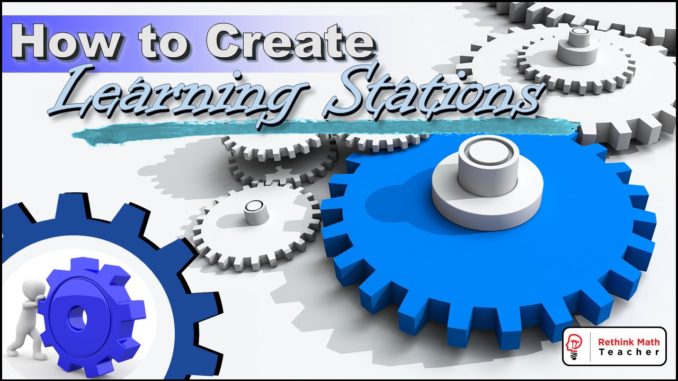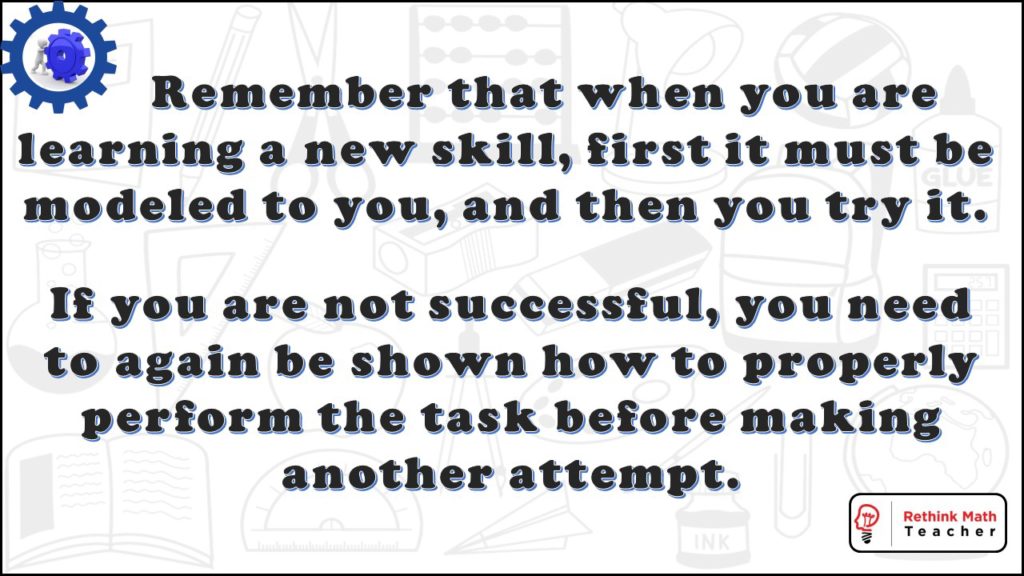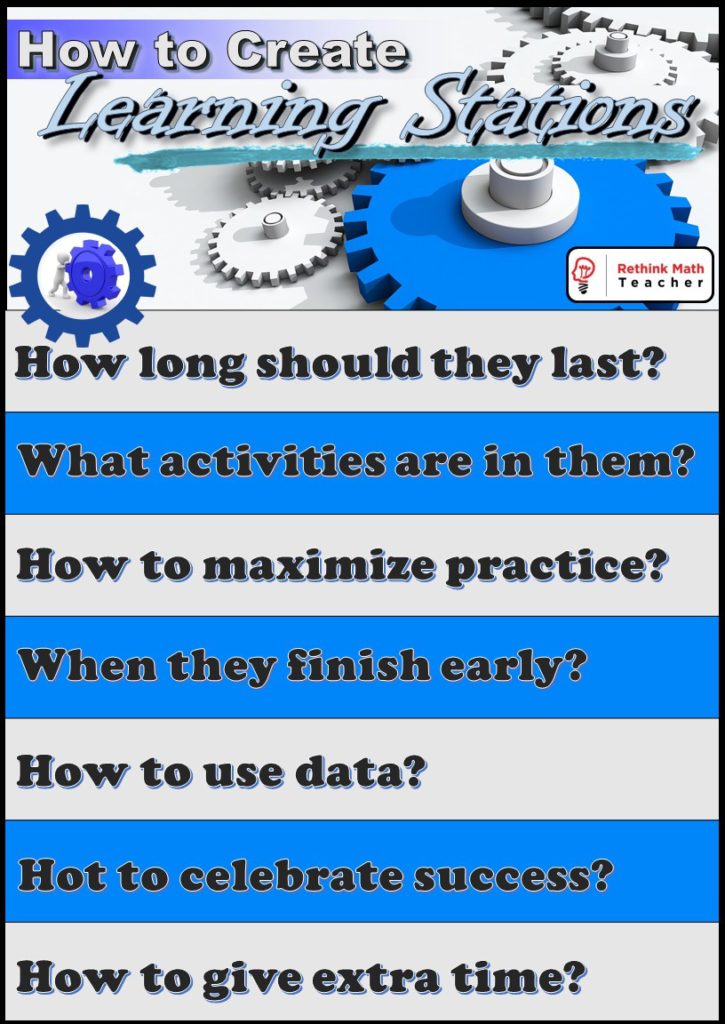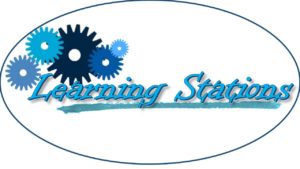
Learning Stations are a powerful tool that allow you to differentiate; reaching every student where they need help. They also allow students to remediate – spending as much time on a skill as they need. Or accelerate – moving on to more advanced skills without having to wait for the class to catch up.
While there are many great benefits to having learning stations, like the fact that they help you celebrate student success, it is much easier to understand as you start to build your learning stations.
If you have not read What is a Learning Station, or Why You Should Create Learning Stations, please click on the links and read the articles. You should also read our article Plugging the Holes – Remediation that Works to learn about creating an outline of your learning stations.
Assuming that you have thought about the progression of your learning stations, and selected the skill that you are going to build a learning station for, we are now going to discuss how you build a learning station.
How long should the learning station be?
Obviously, this is not the same for everyone, but we recommend making a learning station last three days. This is enough time for the student to have a reteach and practice the skill a sufficient amount to become proficient.
What things should the students do in the learning station?
We recommend doing 4 different learning tasks inside the three days. On the fourth day, you should give an assessment, to see if the students have mastered it, and for data collection.
The first day’s task should be a ‘reteach.’ Day 2 and 3 should be independent practice with immediate feedback. And the fourth activity should be an extension – in case the students finish quickly or to be taken home for homework.
The Reteach
The first learning task inside any learning station is a “Reteach.”
Remember that when you are learning a new skill, first it is modeled to you, and then you try to do it yourself. If you are not successful at it, you need to again be shown how to properly perform the task before making another attempt (otherwise you will just make the same mistake).
So provide your students with a ‘reteach’ inside the station.
Remember that your students will be working on different stations at the same time (not everyone will be doing the adding integers station, some will be ahead of this and some will be behind.) So the student must be able to complete the reteach by themselves, without you being there to walk them through the process.
So, if possible, use online videos. I buy cheap headphones so my students may all listen to the teaching videos without having to hear everyone else’s in the room.
However, if classroom technology is not available, you can use reteach worksheets or the guided practice section of the textbook.
Note Taking
Your students must take notes during the reteach. These notes must be kept throughout the three days, so that the student can reference them as they are doing the independent work – since they most likely will not be able to access the videos.
Again, the goal is to be meeting each student where they need help. So different students should be working in different stations, and they’re all going to have questions and need help. To help you, and them, train them to take good notes, and to know how to reference them when they need assistance, before asking you for it.
Independent Practice
Again, think about what it takes to learn something new. You have to practice it over and over again!
So we recommend that day 2 and 3 of your learning station be independent practice. If you have access to technology, try to use websites with immediate feedback, like IXL.com or KhanAcademy.org. However, if technology is not accessible for your students, the task can be accomplished with worksheets.
The key to independent practice
The key to the independent practice is providing students with immediate feedback.
If a student completes a lot of questions, but does them all incorrectly, this is of no value. You want the students to have instant feedback so that they know whether or not they are doing the work correctly. And if they are doing it incorrectly, they are made aware, so that they can consult their notes and learn from their mistakes.
What if they finish too quickly
Because the goal is for the students to move at their own pace, I always have a 4th activity for my learning stations. It’s supposed to be homework on the third day, but if they finish all their in class work before the time is done, now they have something to do – an extension activity.
The extension activity is normally a worksheet, although lately I’ve been creating math puzzle mazes for the students to do – they still practice the activity, but it feels a bit more fun.
I do not give feedback on the extension activity. This is supposed to be them demonstrating mastery over the subject matter, and it is the last thing that they do before they take the quiz. Plus, it’s supposed to be homework, so if they’re doing it in class, that’s fine, but they don’t get another advantage over the students who are not working as fast.
The assessment
After the three day learning station, give your students a short assessment. It should take no more than 15 minutes, and should not be tricky. It is to see if the student fully grasps the skill that we have been working on.
I require an 80% or better for the student to be considered ‘proficient’.
If the student is proficient, they are promoted to the next skill. If not, they are retained, and do that skill again, for another three day cycle.
Celebrate their Success
Make your students feel good about being successful. For some of your students, it might be the first time they ever truly understood something in math class. Or it might be their first true A on a math quiz. So celebrate it.
I recommend two things when celebrating.
1) Clap and cheer
We play “We are the Champions” by Queen as I read the names of students who are successful, and everyone claps for them.
Yes, I know it’s corny. And my students pretend that it is. But they love it!
2) Make a Monument
Memorialize their success. Make it a big deal! Send something home to the parents (like a certificate, or at least a nice email).
And put their name on the wall!
I recommend using banners where they get to put their name under the skill that they have mastered.
Whatever you do, make their success a permanent, and visible thing. Your students will take pride in their work, and even brag about it to their peers, and parents.
Rinse and Repeat
So on day 4 you assessed them, your celebrated their success, and students put their names under their banners to memorialize their accomplishment. Now what?
The next day is a new 3 day rotation of the learning station. Those who passed their assessment yesterday, are onto a new, more challenging station, where they are beginning a new skill.
Those who did not, repeat the station (and they will repeat it again and again, until they master it!)
Don’t forget to PIN this article, to share with your friends or reference later
Want more support?
Visit our page dedicated to Learning Stations resources:



